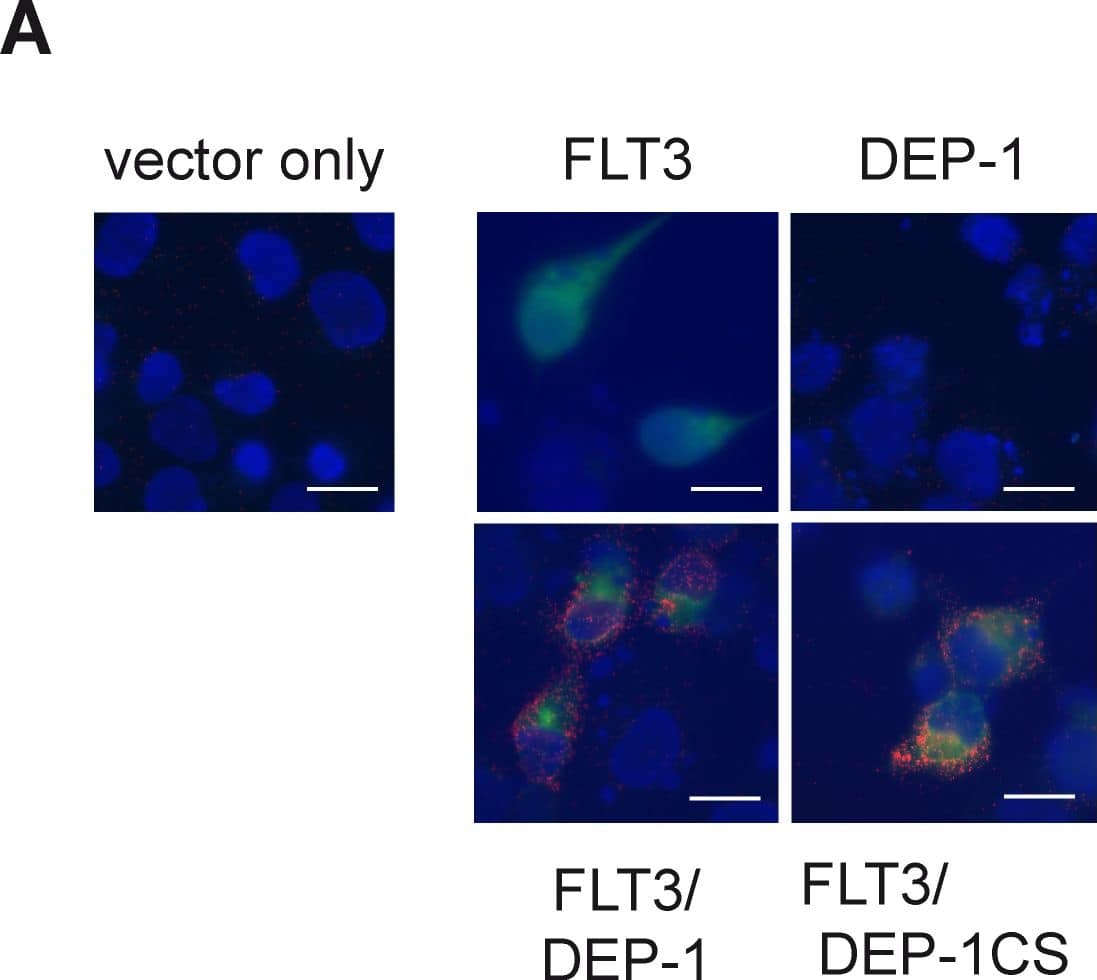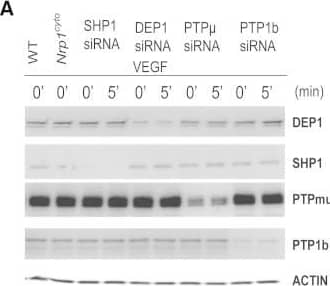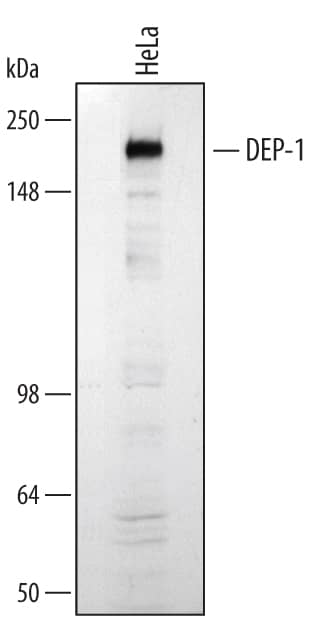Human/Mouse/Rat DEP-1/CD148 Antibody
R&D Systems, part of Bio-Techne | Catalog # AF1934

Key Product Details
Validated by
Species Reactivity
Validated:
Cited:
Applications
Validated:
Cited:
Label
Antibody Source
Product Specifications
Immunogen
Arg997-Ala1337
Accession # Q12913
Specificity
Clonality
Host
Isotype
Scientific Data Images for Human/Mouse/Rat DEP-1/CD148 Antibody
Detection of Human DEP-1/CD148 by Western Blot.
Western blot shows lysates of HeLa human cervical epithelial carcinoma cell line. PVDF membrane was probed with 1 µg/mL of Goat Anti-Human/Mouse/Rat DEP-1/CD148 Antigen Affinity-purified Polyclonal Antibody (Catalog # AF1934) followed by HRP-conjugated Anti-Goat IgG Secondary Antibody (Catalog # HAF109). A specific band was detected for DEP-1/CD148 at approximately 220 kDa (as indicated). This experiment was conducted under reducing conditions and using Immunoblot Buffer Group 1.Detection of Monkey DEP-1/CD148 by Immunocytochemistry/Immunofluorescence
Proximity ligation assay reveals association of DEP-1 with its substrate FLT3.(A) COS7 cells were transiently transfected with expression constructs for FLT3, DEP-1, the catalytically inactive DEP-1 C1239S trapping mutant, or corresponding control plasmids as indicated. Complex formation was measured by in situ PLA using rabbit anti-FLT3 antibodies, goat anti-DEP-1 antibodies, and corresponding secondary reagents. In situ PLA is indicated by red signals of the rolling cycle amplification products (RCPs). FLT3 expression (green) was visualized by additional staining with FITC-labeled anti-rabbit IgG antibodies; nuclei (blue) were counterstained with Hoechst 33342. Scale bars 20 µm. (B), (C) Complex formation of endogenous DEP-1 with endogenous FLT3 in THP-1 cells. Cells were transfected with DEP-1-specific or control siRNA by Nucleofection, were then starved and either left unstimulated or were stimulated with FL (100 ng/ml) for 10 min as indicated. (B) Example images; DEP-1 knockdown efficiency was detected by immunblotting (lower panel). DEP-1-FLT3 complexes as RCPs are shown in red, nuclei are depicted in blue and scale bars represent 20 µm for the overview images and 5 µm for the insets. (C) Quantification of detected in situ PLA signals over 5 images per variant. The data are representative for 3 experiments with consistent results. Image collected and cropped by CiteAb from the following publication (https://pubmed.ncbi.nlm.nih.gov/23650535), licensed under a CC-BY license. Not internally tested by R&D Systems.Detection of DEP-1/CD148 by Western Blot
Rescue of Defective ERK Signaling in VEGF-A-Stimulated Nrp1cyto Arterial EC by Knockdown of PTP1bPrimary arterial EC from Nrp1cyto mice transfected with siRNA specific for the indicated phosphatases were serum-starved and then stimulated with 50 ng/ml VEGF-A165.(A and B) Knockdown of the indicated phosphatases in Nrp1cyto arterial EC shown by immunoblotting (A); PTP1b knockdown was quantified in (B), dashed line indicates normal expression levels.(C and D) ERK and VEGFR2 (Y1175) phosphorylation after knockdown of the indicated phosphatases shown by immunoblotting (C). Quantification of pERK activation is shown in (D) (n = 3, mean ± SD, *p < 0.05). Image collected and cropped by CiteAb from the following open publication (https://pubmed.ncbi.nlm.nih.gov/23639442), licensed under a CC-BY license. Not internally tested by R&D Systems.Applications for Human/Mouse/Rat DEP-1/CD148 Antibody
Immunoprecipitation
Sample: HeLa human cervical epithelial carcinoma cell line, see our available Western blot detection antibodies
Western Blot
Sample: HeLa human cervical epithelial carcinoma cell line
Formulation, Preparation, and Storage
Purification
Reconstitution
Formulation
Shipping
Stability & Storage
- 12 months from date of receipt, -20 to -70 °C as supplied.
- 1 month, 2 to 8 °C under sterile conditions after reconstitution.
- 6 months, -20 to -70 °C under sterile conditions after reconstitution.
Background: DEP-1/CD148
Density Enhanced Protein Tyrosine Phosphatase (DEP-1), also known as CD148, HPTP-eta, and PTP receptor type J (PTPRJ), is an enzyme that removes phosphate groups covalently attached to tyrosine residues in proteins. A large (220 kilodalton) glycoprotein found at the cell surface, DEP-1 levels are increased with high cell density (1). DEP-1 phosphatase activity is enhanced by basement membrane proteins (2), suggesting it is involved in regulating cell adhesion and contact interactions. High levels of expression dampen PDGF (3), VEGF (4), and T-cell receptor (5) responses. DEP-1 is widely expressed in tissues, particularly ones forming epithelioid monolayers (6). In the immune system, DEP-1 is found on all cell lineages and is highest on granulocytes (7). Dep-1 is the mutated gene in the Susceptibility to Colon Cancer locus Scc1, which is altered in many human colorectal adenomas (8). Gene knockout mice lacking DEP-1 die at midgestation due to failures in cardiovascular development (9). DEP-1 dephosphorylates a variety of proteins, including the HGF (10), PDGF (11), and VEGF (4) receptors, and beta‑catenin (12). The recombinant protein is the intracellular region of DEP-1 containing the catalytic domain. Over aa 997-337, human Dep-1 shares 95% aa sequence identity with mouse and rat Dep-1.
References
- Ostman, A. et al. (1994) Proc. Natl. Acad. Sci. USA 91:9680.
- Sorby, M. et al. (2001) Oncogene 20:5219.
- Jandt, E. et al. (2003) Oncogene 22:4175.
- Lampugnani, M.G. et al. (2003) J. Cell Biol. 161:793.
- Baker, J.E. et al. (2001) Mol. Cell. Biol. 21:2393.
- Borges, L.G. et al. (1996) Circ. Res. 79:570.
- de la Fuente-Garcia, M.A. et al. (1998) Blood 91:2800.
- Ruivenkamp, C.A. et al. (2002) Nat. Genet. 31:295.
- Takahashi, T. et al. (2003) Mol. Cell. Biol. 23:1817.
- Palka, H.L. et al. (2003) J. Biol. Chem. 278:5728.
- Kovalenko, M. et al. (2000) J. Biol. Chem. 275:16219.
- Holsinger, L.J. et al. (2002) Oncogene 21:7067.
Long Name
Alternate Names
Gene Symbol
UniProt
Additional DEP-1/CD148 Products
Product Documents for Human/Mouse/Rat DEP-1/CD148 Antibody
Product Specific Notices for Human/Mouse/Rat DEP-1/CD148 Antibody
For research use only


